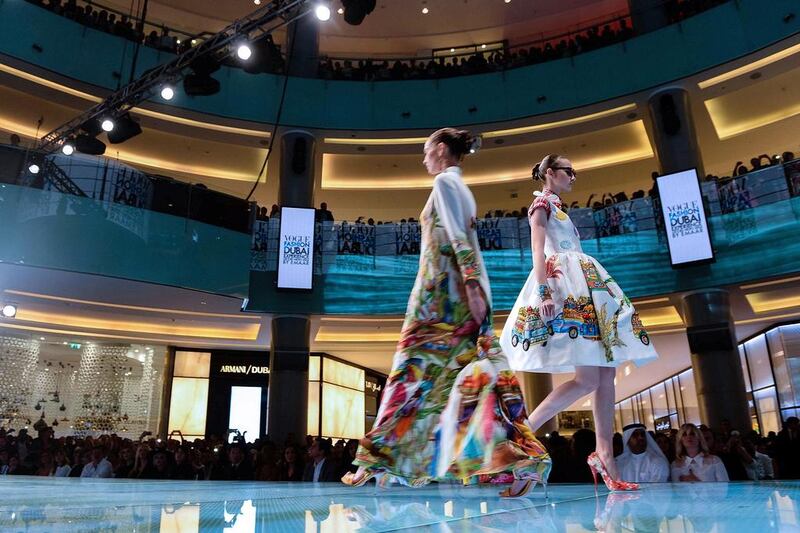LONDON // The publisher Condé Nast has not always considered the Arab world “en vogue”.
About 10 years ago, the US media major strongly ruled out licensing an edition of its flagship fashion title on these shores.
But Condé Nast now says there is a solid case for publishing a regional version of its Anna Wintour-edited US Vogue – and possibly other magazines such as GQ, Wired and Glamour – in what it describes as a "thriving" Arabian Gulf market.
Its international arm this month announced it had reached a licensing agreement with the Dubai-based Nervora, the publisher of Condé Nast's Style.com/Arabia fashion website, to produce Vogue Arabia.
Deena Aljuhani Abdulaziz, a Middle East fashion guru who married into the Saudi royal family, has been appointed editor in chief, with the Style.com/Arabia website – currently published in English and Arabic – to be rebranded Vogue Arabia this autumn, and a printed edition of the fashion title set to follow in spring.
"There has been a growing demand for Vogue in the region. We hear it from our advertisers, who see the Arabian Gulf as a key market," said Jonathan Newhouse, the chairman and chief executive of Condé Nast International.
That is certainly a change of tone from an email reportedly sent by Mr Newhouse in 2007, in which he vehemently rejected the idea of a Middle East version of Vogue. The executive reportedly wrote that the Middle East was too violent, and that it was incompatible with Vogue given a "powerful fundamentalist, religious element that rejects western values".
Strong words indeed. So what has changed?
Mr Newhouse puts it down to both a makeover in the Gulf’s fashion culture and his own company’s growing experience in the market.
“Nine years ago the Arabian Gulf did not possess the deep interest in fashion and the range of shopping centres and designer stores that are present today,” he said in response to a question about his 2007 email.
"Moreover, we as a company did not have any experience publishing in the region. Since then, we have launched through a licensee two brands, Conde Nast Traveller and AD, which is devoted to architecture and home decoration. Success with these brands gave our company the experience and deeper understanding of the market, which gave us the confidence to start Vogue Arabia."
The growing presence of haute couture in the malls and boutiques of the Gulf has been matched by increasing interest from regional investors in global fashion brands.
Two major deals emerged last month: the Gulf investment firm Investcorp said it bought a majority stake in the Italian menswear company Corneliani, while the Qatari fund Mayhoola for Investments agreed to buy the French fashion house Balmain.
But the arrival of Vogue Arabia also comes at a time of a global slowdown in the personal luxury goods market, as well as economic uncertainty in the Gulf given the lower oil prices.
Mr Newhouse said these are merely “short-term and transitory” trends.
“We don’t make long-term business decisions based on the price of crude,” he said. “The Arabian Gulf region is thriving, with a growing segment of the population who are deeply interested in fashion. We make decisions based on these long-term considerations.”
Shashi Menon, the chief executive of Nervora, said there had been an incredible response to the announcement about the launch of Vogue Arabia.
"The region has been waiting for it for quite some time. There is just a lot of pent-up excitement for what Vogue can do for the region," he said.
Mr Menon said his company's mission with Vogue Arabia is both commercial and cultural, in terms of being a bridge between East and West.
“Over the past few years, the Middle East has really been in the process of an ongoing transition to emerge as more than just a consumer market for fashion. To not just be a place where people go and shop, but rather a culture and a place that can create,” Mr Menon said.
The Dubai publisher acknowledged that there had been a slowdown in the growth of luxury retail, partly because of the decline in tourism from Russia and China. But he added that this might actually strengthen Vogue's appeal with advertisers.
"Certainly, Vogue is more sheltered than other brands," Mr Menon said. "When markets get tight, brands spend more time thinking about where they want to prioritise and consolidate their budgets in the fashion and luxury space. More often than not, that happens to be Vogue as a publication."
Given that Condé Nast is now making its long-awaited move to launch Vogue in the Arab world, could more of its publications follow – such as the men's magazine GQ, or technology title Wired?
Karina Dobrotvorskaya, the president of Condé Nast International’s new markets and brand-development division, said this could be on the cards.
“We do believe in the Arabian market. There is a huge appetite for quality media – as well as for great luxury, fashion, beauty and technology content,” she said.
"So we do not rule out the possibility of launching GQ, Wired or Glamour, but we would love to establish our flagship title – Vogue – first. As soon as it is done, we will be ready to discuss our future expansion."
So it seems the Arab world is very much in fashion at Condé Nast – and it is a trend that could continue for seasons to come.
business@thenational.ae
Follow The National's Business section on Twitter





